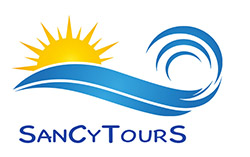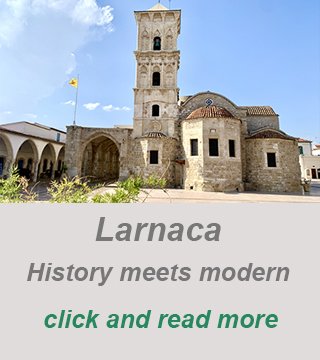Larnaca – visit the best places with your private guide
Larnaca has an eventful history. With its palm-lined promenade, it is a popular tourist destination on the south coast of the island. Old and new mix in the town, which, despite its many hotels, is not purely a tourist centre.
With the handover of Cyprus by the Ottomans to the British, Larnaca was rapidly upgraded from an Ottoman provincial town after their arrival; in line with European standards, the British renewed roads and infrastructure, began draining the salt marshes and established a town parliament headed by a mayor. With the end of British colonial rule, the Turkish occupation of the northern part of the island and the loss of Famagusta, Larnaca experienced an upswing as a port, business and tourism location and, after the closure of Nicosia airport in the demilitarised zone, was given the most important airport on the island.
Larnaca castle
 Larnaka Castle was originally a small fort built by the Byzantine rule probably in late 12th century. The city gained importance during the medieval ages after the Genovese occupied the main port of the country and the need for a new port town emerged. Soon after Larnaca became one of the main ports of the Kingdom of Cyprus and the need of a castle protecting the city and the harbour emerged. Between the years 1382-1398 the small Byzantine fortification located near the harbour was upgraded to a more substantial castle.
Larnaka Castle was originally a small fort built by the Byzantine rule probably in late 12th century. The city gained importance during the medieval ages after the Genovese occupied the main port of the country and the need for a new port town emerged. Soon after Larnaca became one of the main ports of the Kingdom of Cyprus and the need of a castle protecting the city and the harbour emerged. Between the years 1382-1398 the small Byzantine fortification located near the harbour was upgraded to a more substantial castle.
In the 18th century the castle began to lose importance and was abandoned. The castle was occupied by German troops during World War I and used as a military outpost. At the end of the war the castle was recaptured by the British and turned into a prison. The last execution took place in 1948. During the Cypriot Civil War, the castle was used by Greek Cypriots as a war prison.
Today the castle is a small museum, with antiquities from early Christian, Byzantine and post-Byzantine artefacts.
St.Lazarus Church
 The Church of Saint Lazarus is a late-9th century church in Larnaca. According to Orthodox tradition, sometime after the Resurrection of Christ, Lazarus was forced to flee Judea because of rumoured plots on his life and came to Cyprus. There he was appointed by Paul and Barnabas as the first Bishop of Kition (present-day Larnaca). He is said to have lived for thirty more years and on his death was buried there for the second and last time. The Church of Agios Lazaros was built over the reputed (second) tomb of Lazarus.
The Church of Saint Lazarus is a late-9th century church in Larnaca. According to Orthodox tradition, sometime after the Resurrection of Christ, Lazarus was forced to flee Judea because of rumoured plots on his life and came to Cyprus. There he was appointed by Paul and Barnabas as the first Bishop of Kition (present-day Larnaca). He is said to have lived for thirty more years and on his death was buried there for the second and last time. The Church of Agios Lazaros was built over the reputed (second) tomb of Lazarus.
Under Frankish and Venetian rule (the 13th to 16th centuries), the church became Roman Catholic. A stone covered portico (stoa) of Gothic style was added on its south side during this time.
For the next two hundred years it was used for both Orthodox and Catholic services. In 1857, after the Ottoman authorities allowed Cypriot churches to have bell towers, the church’s bell-tower was rebuilt in a Latinate style.
Halan Sultan Tekke Mosque
 The important sacred Muslim pilgrimage site in Cyprus is the Mosque of Hala Sultan. It is located in the center of a spectacular garden on the western shore of the Salt Lake, in the south-west of Larnaca. The mosque was built over a tomb believed to belong to Umm Haram, foster mother of the Prophet Muhammad and wife of one of Moawia’s most senior officers, who led two devastating raids on Cyprus in 649 and 650 AD. Umm Haram died on arrival as a result of an accident. The mosque was built much later, sometime before 1787, along with dwellings and water cisterns, making the shrine very popular. In 1816 the mosque as we see it today was completed.
The important sacred Muslim pilgrimage site in Cyprus is the Mosque of Hala Sultan. It is located in the center of a spectacular garden on the western shore of the Salt Lake, in the south-west of Larnaca. The mosque was built over a tomb believed to belong to Umm Haram, foster mother of the Prophet Muhammad and wife of one of Moawia’s most senior officers, who led two devastating raids on Cyprus in 649 and 650 AD. Umm Haram died on arrival as a result of an accident. The mosque was built much later, sometime before 1787, along with dwellings and water cisterns, making the shrine very popular. In 1816 the mosque as we see it today was completed.
Saltlakes and Flamingos
 The Larnaca Salt Lake is one of the most important habitats for waterfowl in Europe. The lake is actually one of four lakes in Larnaca.
The Larnaca Salt Lake is one of the most important habitats for waterfowl in Europe. The lake is actually one of four lakes in Larnaca.
As the lake fills with water and becomes rich in nutrients during the winter months, thousands of migrating birds like the including the Greater Flamingo stop over from between the months of November to March, feeding on tiny brine shrimp. When food reserves run out, the birds then continue their journey towards Africa.
Aqueduct of Kamares
 The ancient aqueduct of Kamares is located west of Larnaka city centre and northwest of the Larnaka salt lake. The Greek word Kamares means arch. The whole structure consists of 75 arches.
The ancient aqueduct of Kamares is located west of Larnaka city centre and northwest of the Larnaka salt lake. The Greek word Kamares means arch. The whole structure consists of 75 arches.
The aqueduct was built and financed in 1745 by the Ottoman governor of Larnaka, Abu Bekir Pasha, to solve the problem of water shortage in the city. The aqueduct supplied the city and the port of Larnaka with water from the Mountains. The monument is one of the most significant works of the Ottoman period and in use until 1939.
Author: Jürgen Derichs am 6. März 2024 07:21, category: Best places at Cyprus to visit, comments per feed RSS 2.0, comments closed.










